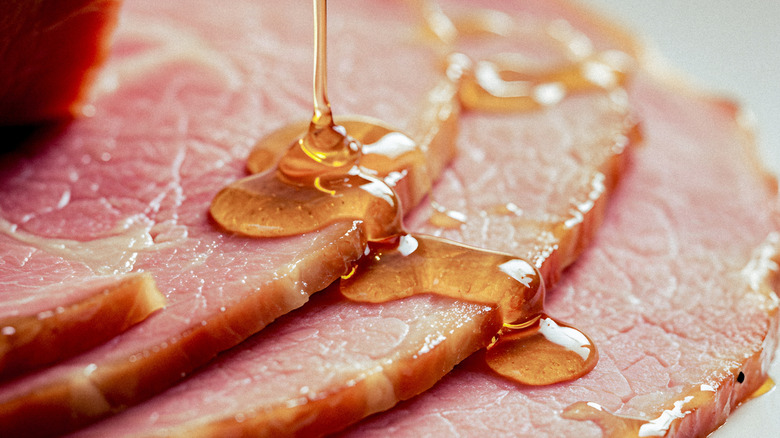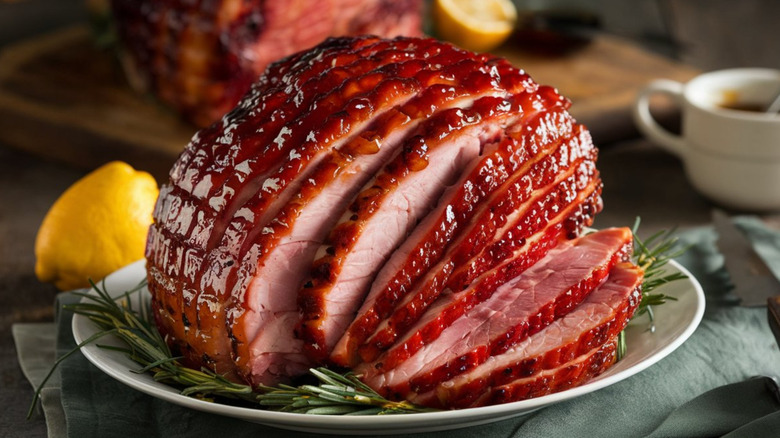Follow This Glazing Rule For The Perfect Ham
Glazed ham is a staple of any festive holiday spread, but it can be deceptively tricky to perfect. Leave it in the oven too long and the glaze can burn, or add too many sweet elements and the flavor of the ham can become unbalanced. Whether you're going for a classic honey glaze or experimenting with a more unique variation, following the right steps is key to achieving that beautifully caramelized, golden finish. To find out more, Food Republic spoke with Maricel Gentile, chef and owner of Maricel's Kitchen and author of "Maricel's Simply Asian Cookbook."
According to Gentile, the secret to a perfect glaze is all about timing. Specifically, the glaze should be added "during the last 30 to 45 minutes of baking," she explained. "The ham has already developed flavor from slow roasting, so this is when the glaze can caramelize without burning." Glazes are packed with sugars, and the heat of the oven transforms sugar into rich, complex flavors and gives the crust a deep, golden color. This is what creates those irresistible notes of sweetness and a slight nuttiness that perfectly complement the savory meat. But it's a slippery slope — push it too far and the sugars can quickly move from caramelized to burnt, leading to a bitter flavor and a scorched, gloopy texture that can overpower the ham instead of complementing it. For the best results, "brush [the glaze] on in layers every 10 minutes or so[, so] it forms that glossy, sticky finish everyone loves," Gentile advised.
Other essential glazing tips
Baking ham is something of an art, and if you follow the right steps, you'll quickly become a master. When adding the glaze, following a few simple yet impactful tips can boost the final product. "Warm the glaze slightly before brushing so it spreads evenly," Maricel Gentile recommended. "Baste from top to bottom, letting gravity pull the glaze over the ham's curves."
According to Gentile, another often overlooked step is scoring — "those shallow diamond [cuts let] the glaze seep in and coat every bite," she explained. While this step is super easy and makes a huge difference, if you're short on time, simply poke a few holes into the skin with a fork. Scoring also presents the opportunity for you to carve beautiful patterns into your ham, giving it a little extra flair that'll be sure to garner compliments. "If you like a little extra shine, give it one last brush right after removing it from the oven," she added.
"Avoid rushing the rest time," Gentile added. This is one of the key tenets of cooking any meat, from the most luxurious A5 wagyu steaks to the humble chicken breast. When exposed to heat, the muscle fibers contract and push juices towards the surface. Allowing the meat to rest gives time for the muscle fibers to relax and the juices to redistribute, ensuring each flavorful slice is tender and moist. Cut too soon, and you're practically spilling those precious juices away. We recommend letting your glazed ham rest for around 20 minutes.
Ingredients for the perfect glaze
The process of making a glaze is where you can let your creativity shine. A good glaze typically starts with two essential components: a sweet element, like honey or brown sugar, and a liquid like fruit juice or cola. These are mixed together until they reach a smooth, thick consistency that can beautifully coat the ham. To elevate the flavor even further, you can reduce the mixture in the pan. As the mixture simmers in the pan, the sugars will begin to caramelize, creating an even deeper flavor and glossy finish. The key to a perfect reduction is patience — go in too hot and the sugars will burn. Take it off the heat once it reaches the desired syrupy consistency, remembering to stir continually!
"My favorite glaze mixes honey, brown sugar, pineapple juice, sometimes with a splash of rice vinegar for brightness," Maricel Gentile told us. "The sugar gives a deep caramel note, and the pineapple brings that tropical sweetness I grew up with in the Philippines." Experimentation is part of the fun with a glaze recipe. Instead of a honey-based glaze, you could swap honey for ginger ale to add a zesty sweetness. For a richer and more complex flavor, try using molasses as your sweet element, whose robust taste will add much more character than plain crystal sugar. Don't forget the spices either! For a festive Christmas or Thanksgiving glazed ham, consider seasonal additions like cloves, allspice, or cinnamon to add a warm, cozy vibe to your dish.



